The amazing record of 1940s battleship USS Wisconsin
Posted by Chris Graham on 29th February 2024
James Hendrie spotlights the 1940s battleship USS Wisconsin, recipient of six battle stars in WW2, the Korean War and Operation Desert Storm.

USS Wisconsin in 1991, following her deployment for Operation Desert Shied and Storm, returning to Norfolk Naval Air Station. (All photos copyright Michael W Pocock and www.martitimequest.com)
It’s 70 years since USS Wisconsin underwent a major overhaul at the New York Naval Shipyard to allow her to serve in the Korean Theatre. Wisconsin was recommissioned on 3 March 1951 and arrived on the ‘Korean bomb line’ on 3 December that year. Her participation in the Korean War resulted in the awarding of one of her six battle stars. The other five were awarded for her World War II service. She also received other awards for her participation in Operation Desert Storm.
Wisconsin was an Iowa class battleship built at the Philadelphia Naval Shipyard in Philadelphia, Pennsylvania. She was launched on 7 December 1943, two years, to the day, after the Japanese attack on Pearl Harbor. During her long naval service, Wisconsin served during World War II as well as the Korean War and, after a modernisation programme, she took part in Operation Desert Storm and Desert Shield. In September 1991 Wisconsin was decommissioned, stricken from the Naval Vessel Register, and on 17 March 2006 she became a museum ship.
The City of Norfolk took over the stewardship of Wisconsin in 2010. She is advertised as being one of the largest and last battleships built by the US Navy. Visitors are transported back in time as they walk along Wisconsin’s teak decks. The ship is also available for events and functions. This includes the Wardroom, used by Wisconsin’s officers, but which now can host up to 80 guests.
Visitors can walk on the main deck and see the ship’s gun turrets. Other sought-after locations on this once-mighty battleship include the Captain’s and Admiral’s cabins, both of which can seat a dozen or so guests.
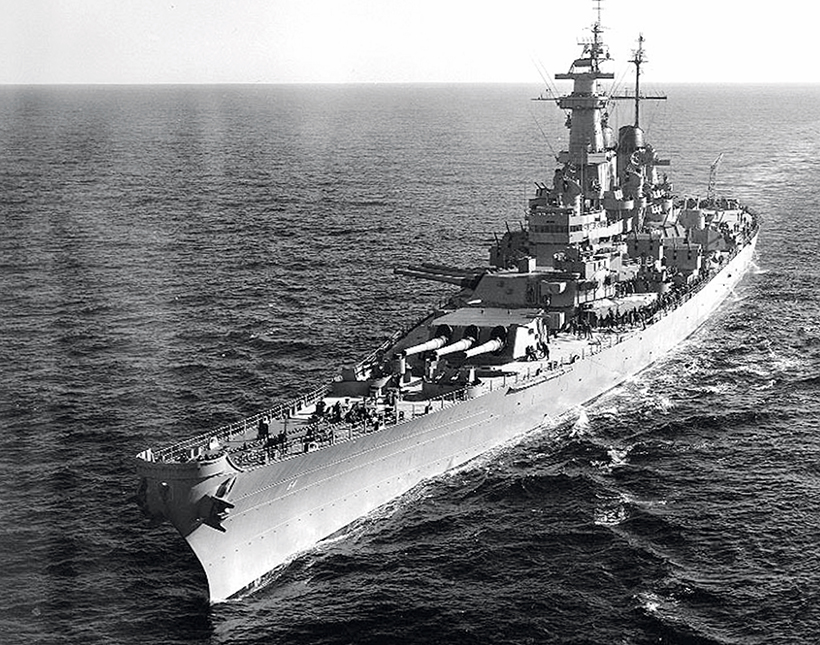
Wisconsin operating off Korea in 1952.
Wisconsin’s keel was laid down on 25 January 1941 and she was launched on 16 April 1943. She was the third of four Iowa class battleships. Her main gun battery consisted of nine 16in Mk.7 guns, which could fire 2,700lb armour-piercing shells up to a range of 20 miles at two rounds per minute. The secondary battery consisted of 20 5in guns in ten twin turrets, which could hit targets up to ten miles away, firing 55lb shells at a rate of 15 per minute. Wisconsin also carried a number of Oerlikon 20mm and Bofors 40mm anti-aircraft guns for air defence.
During the 1980s, when Wisconsin was reactivated, the anti-aircraft guns were removed and she was then fitted with four 20mm Phalanx Close In Weapons System (CIWS) and 32 BGM-109 Tomahawk cruise missiles. Wisconsin retained three Vought OS2U aeroplanes, which were catapult-launched observation aircraft used on American battleships and cruisers during World War II. They were employed on patrols, for reconnaissance and to rescue downed pilots.
Impressive armour
Wisconsin and her sister USS Missouri had 14.5in bulkhead armour. The rest of her armour was 12.1in belt, 11. 6in to 17.3in Barbettes, 19. 5in for the turrets, 1.5in on the main deck, and 6in on the second deck. Propulsion was from four geared Westinghouse turbines generating 212,000shp and eight 600psi Babcock & Wilcox steam boilers. She had inboard and two outboard propellers.
After her initial trials in Chesapeake Bay, in July 1944, and then a shakedown cruise in the West Indies, Wisconsin returned to the shipyard for alterations and repairs. She then joined the Pacific Fleet to support the American advance against the Japanese in the Philippines. Wisconsin supported the occupation by American forces of Luzon. It was here and on the Leyte operation, that Wisconsin earned her first battle star.
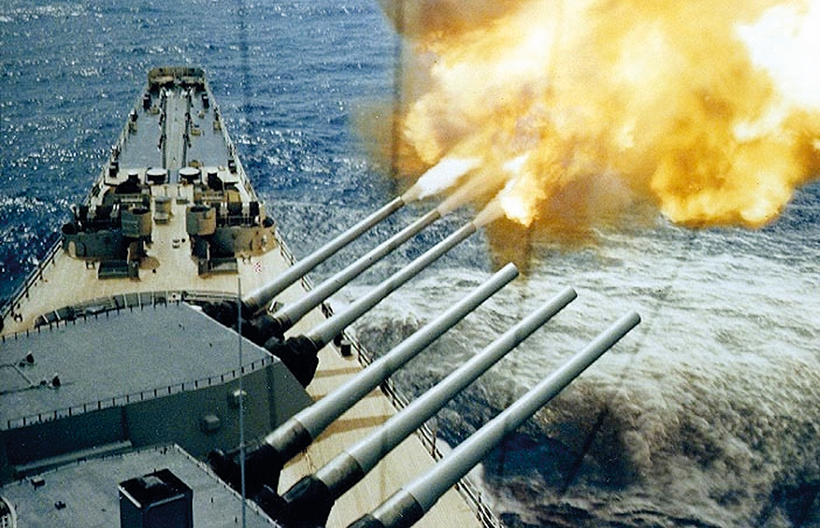
Wisconsin’s 16in guns in action during the Korean War in 1952. These guns could fire shells at targets up to 20 miles away.
There followed a move to join the American Fifth Fleet, and her powerful 16in guns were used on Japanese targets on Okinawa, where her fourth battle star was awarded. Wisconsin offered protection to the American carrier force, especially against the increasing number of Japanese Kamikaze attacks. Towards the end of the war, Wisconsin was training her guns onto the Japanese mainland, gaining her a fifth battle star. She was part of the occupying force after the Japanese surrendered on 15 August 1945.
Wisconsin was used after the end of the war to bring members of the American armed forces home from the war zones. In 1946 Wisconsin was overhauled at the Norfolk Naval Shipyard and then sailed for a tour of South America. During 1947 she served as a training ship before she was assigned to the Atlantic Reserve Fleet in 1948. There she would have stayed, but the Korean War resulted in her being recomissioned, together with the other Iowa class battleships.
In Korean waters, her role was to provide gunfire support for the American and Republic of Korea (ROC) forces engaged in land-based actions. During this conflict Wisconsin took her first direct hit, from a Howitzer shell, but little damage was caused and there were no casualties. Wisconsin’s armour was designed to withstand a direct hit from an 18in armour-piercing shell from ten miles away.
Wisconsin took part in various other actions, including supporting United Nations (UN) troops in the Korean War theatre. On 10 January 1952 she hosted the South Korean President Syngman Rhee and his wife. Having served as the flagship of the 7th Fleet, Wisconsin was relived of this duty by USS Iowa and returned to Norfolk Naval Shipyard. She returned to training ship duties, but did take part in Operation Mainbrace, a NATO exercise held in Scottish waters, as part of the Atlantic Fleet.
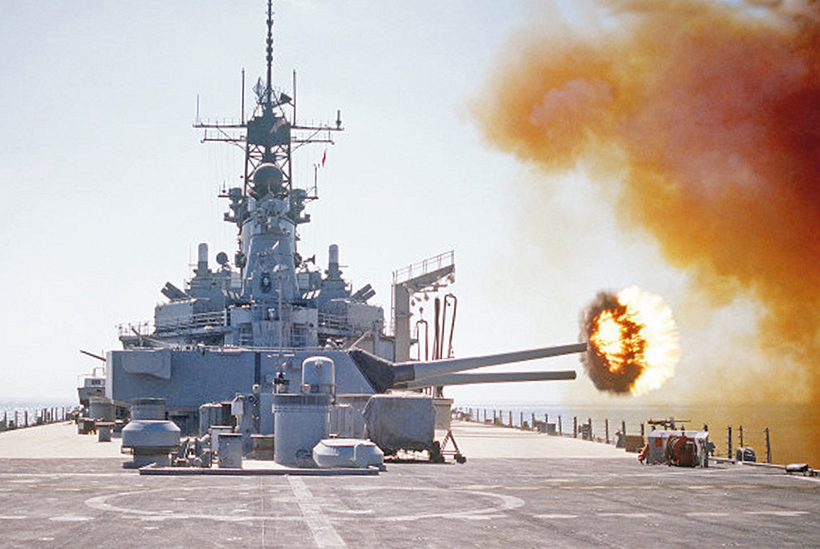
Gunnery practice with Wisconsin’s 16in guns in the Persian Gulf during Operation Desert Shield.
Further exercises and a major overhaul at the New York Naval Shipyard followed. In February 1957 Wisconsin took part in exercises off Puerto Rico, and two months later she was in the Mediterranean taking part in the NATO Exercise Red Pivot. However, by November 1958 she was once more deactivated.
Wisconsin then joined the US Navy Reserve Fleet at Bayonne. Her removal from service left the US Navy without a battleship in service for the first time since the late 1890s. Wisconsin was moved to join Iowa at the Philadelphia Naval Shipyard, and she remained there into the mid-1980s.
As part of an initiative by the then President Ronald Reagan to create a ‘600-ship Navy’, Wisconsin was reactivated on 1 August 1986. The other Iowa class battleships were also reactivated in 1986. However, for World War II-era ships, extensive modernisation and upgrading works were required. Wisconsin underwent upgrades to her radar and fire control system, and her older style cannons were replaced.
Her new weapons included 16 RGM-84 Harpoon Anti-Ship Missiles, 32 BGM-109 Tomahawk cruise missiles, and four 20mm Phalanx CIWS. Phalanx CIWS consisted of 20mm Gatling guns firing 50 rounds a second for defence against anti-ship missiles and aircraft attacks. The Harpoon was an all-weather ‘over-the-horizon’ anti-ship missile, which flew close to the water to evade defences. The Tomahawk Cruise missile was a long-range, all-weather, jet-powered and subsonic land attack weapon system.
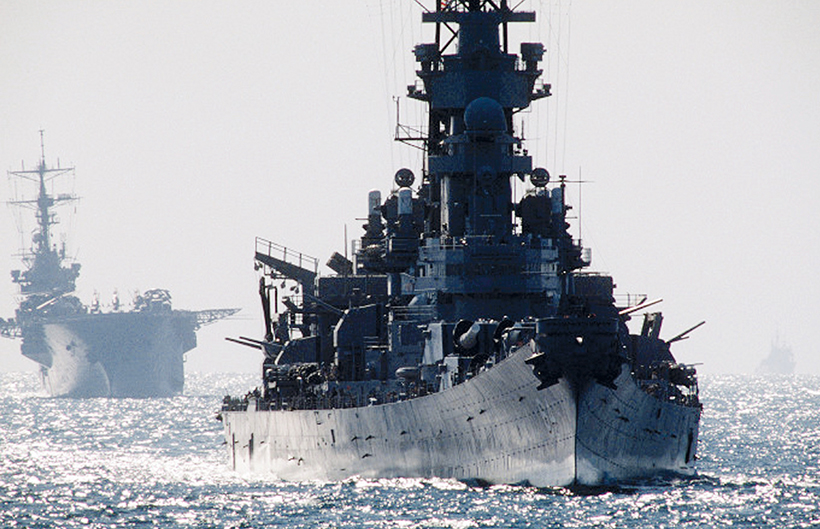
Wisconsin with USS Tripoli in the Persian Gulf in October 1987.
An Unmanned Aerial Vehicle (UAV) also became part of Wisconsin’s arsenal of new weaponry. UAVs were used for gunnery spotting, reconnaissance and surveillance, with the ability to help amphibious forces attacking land-based targets. Wisconsin was recomissioned in 1988 and homeported at Naval Station Norfolk Virginia.
Following the Iraq invasion of Kuwait, Wisconsin and USS Missouri were back in a war zone. Both ships launched Tomahawk Land Attack Missiles, some as part of Operation Desert Storm. Wisconsin’s guns were also fired in anger for the first time since 1952. The UAV capability of the Iowa Class battleships was used to direct salvos from the ships’ 16in guns against Iraqi targets.
Wisconsin steamed 8,500 miles from Norfolk Naval Ship Yard to the Persian Gulf in just 16 days. While she was operating there, a platoon of Iraqi troops on Failaka Island actually surrendered to one of her UAVs. Wisconsin and Missouri delivered a million pounds of ordnance on Iraqi targets. Wisconsin returned to the US on 25 March 1991, and she and the other three remaining Iowa battleships were decommissioned, making the Gulf War the last time US battleships took part in a conflict.
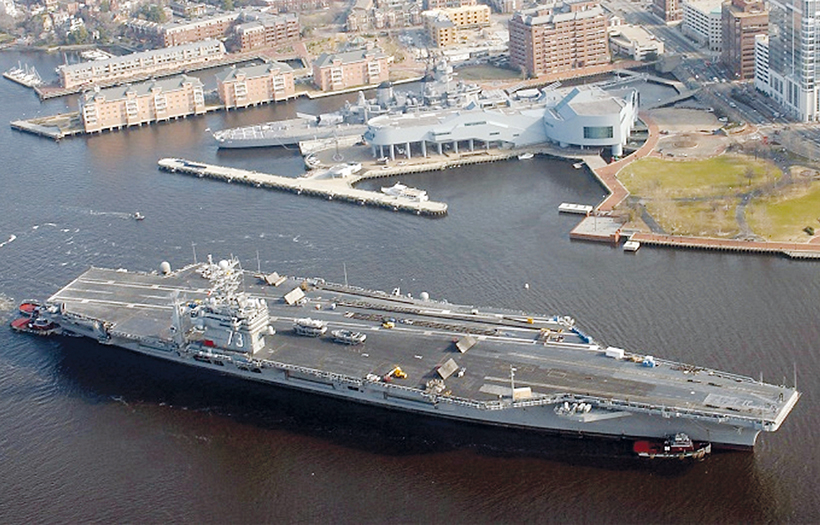
The aircraft carrier USS George Washington (CVN-73) passes USS Wisconsin at the battleship’s ‘museum home’ at Nauticus in Norfolk, Virginia.
Decommissioned
Wisconsin was officially decommissioned on 30 September 1991 and joined the Reserve Fleet at the Philadelphia Naval Shipyard. When this closed in 1996, Wisconsin moved to the Norfolk Naval Ship Yard. Finally, in December 2000, she arrived at Nauticus, The National Maritime Center, in Norfolk, Virginia. In 2001 she became a museum ship, but still remained part of the Reserve Fleet and was still maintained by the US Navy. Given the high cost of modernising Wisconsin and Iowa, they were stricken from the US Naval Register in 2006 and offered as museum ships.
Therefore, Wisconsin, affectionately known as ‘Wisky’, with her six battle stars and an illustrious US Naval career, became a floating museum. The City of Norfolk formally accepted her transfer to their care in a ceremony on 16 April 2010. It is now possible to visit parts of the battleship on a self-guided tour. Information boards on display in the Nauticus building itself relate Wisconsin’s long history.
It is fitting that USS Wisconsin, which served the US Navy in three war zones, and whose career spanned six decades, as well as holding the distinction of being the last battleship to fire shots in anger, is preserved as a fine example of US naval history.
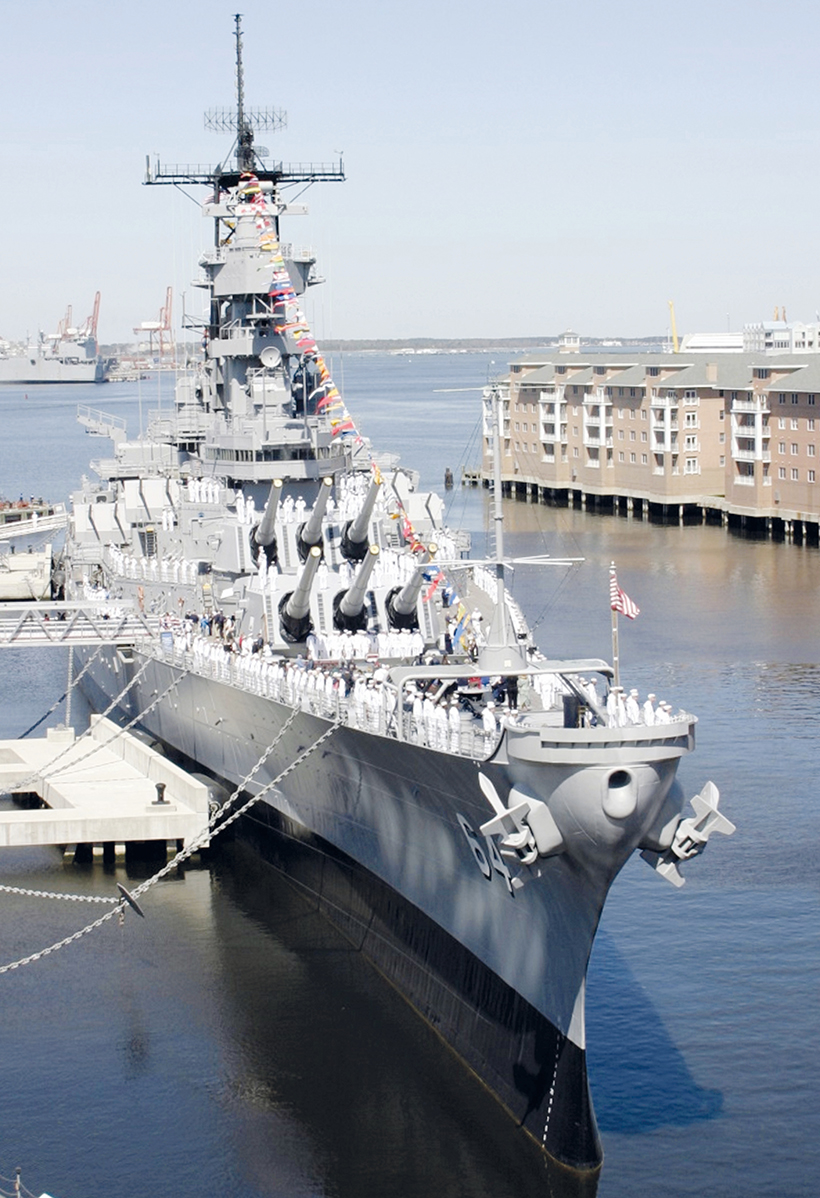
USS Wisconsin at Nauticus: one of the largest and last battleships built for the US Navy, she was awarded six battle stars during her long and illustrious career.
Wisconsin and the other Iowa class battleships came into service just as the power and might of the aircraft carrier was taking over from naval battleships in navies across the globe. But, despite this, these battleships served the US Navy well during their long and illustrious careers.
This feature comes from the latest issue of Ships Monthly, and you can get a money-saving subscription to this magazine simply by clicking HERE
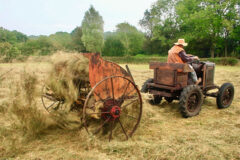
Previous Post
A fantastic vintage hay-making day
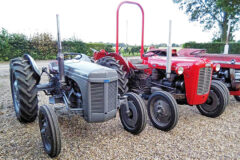
Next Post
A pair of my favourite Ferguson and Massey Ferguson tractors!



